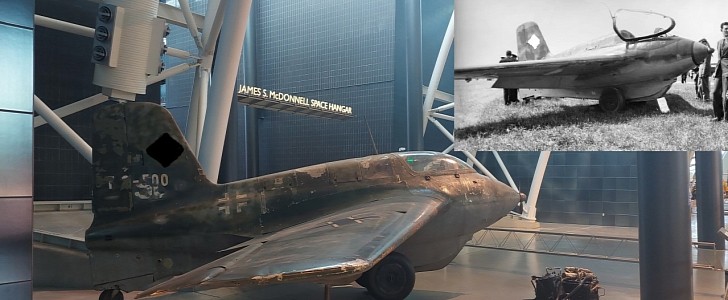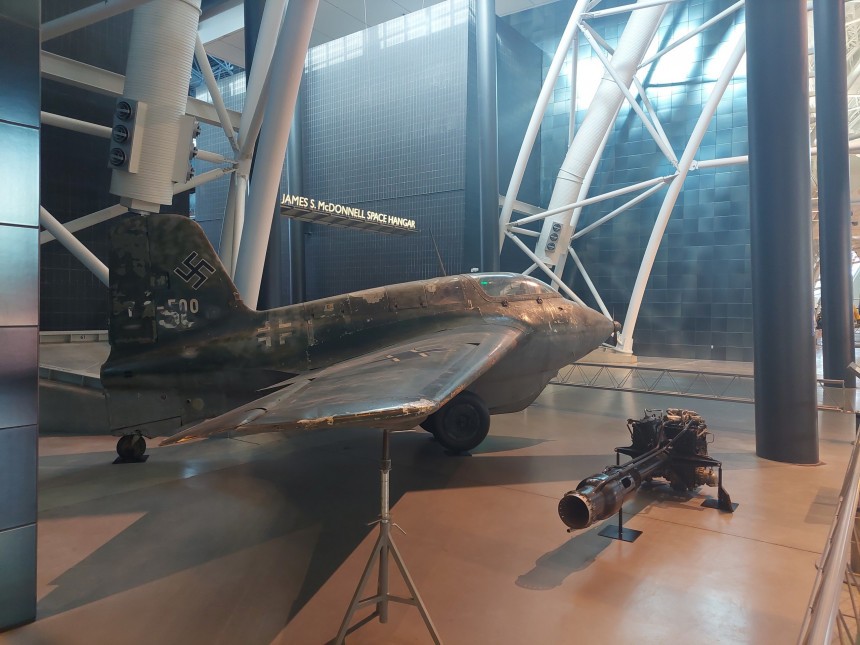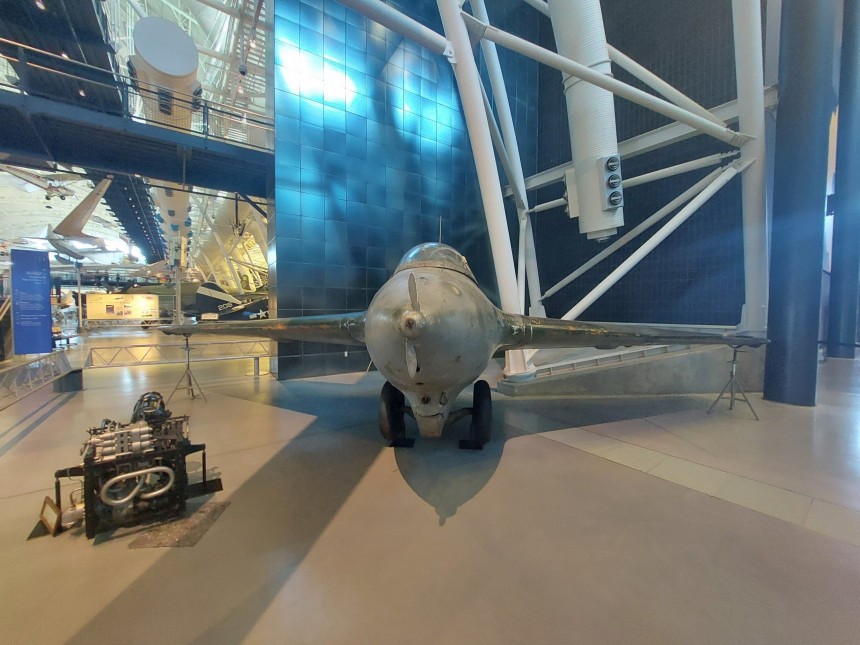It takes more than a few mental gymnastics to appreciate the scale of the achievement of the Messerschmitt Me-163 Komet rocket interceptor. Then again, seeing the less-than-stellar-looking example at the Steven Udvar-Hazy Center sure does show its more human side.
The Steve Udvar-Hazy Center annex of the Smithsonian Air and Space Museum in Chantilly, Virginia, has one of if not the single largest collections of Second World War experiential German aircraft in North America. Many of them reside in their own section of the vast facility. Icons like the Dornier Do-335 twin-engined interceptor and the Arado Ar-234 jet bomber.
But sitting all by itself, just outside the entrance to the museum's spacecraft exhibits, lies a rocket-powered Messerschmitt Komet that's, at the very least, solidly in barn-find condition. It's fitting that this rocket fighter is in such close proximity to Space Shuttle Discovery in the museum's hangar. We may never have had one without the other.
This particular example is the Me 163 B-1a variant, serial number 191301. It was one of five Komets sent to the United States as war trophies and experimental testbeds in the immediate aftermath of Allied victory in Europe. The first examples arrived at Freeman Field, Indiana, in the summer of 1945.
Komet 191301 was given a foreign equipment designation of FR-500 while in Indiana. It was then flown aboard aca U.S. Military cago aircraft to Muroc dry lake in California. A place we would recognize today as Edwards Air Force Base. The father of the 163 project, Dr. Alexander Lippish, was on hand for the Komet's first glide test on U.S. Soil.
The Komet was towed to 30,000 feet (9,000 meters) behind a Boeing B-29 Superfortress bomber. Much in the same fashion as early German tests where Komets were towed behind Heinkel He-111 bombers instead. Komet 191301 glided safely back down to Earth as if it was back in native Germany. Powered flights were planned, but questions about the structural rigidity in the wings scrapped those plans. Instead, the Bell X-1 became the first U.S. rocket plane just one year later.
Meanwhile, Komet 191301 was left to sit derelict in storage at Norton Air Force Base in California and then in the Smithsonian institution's Paul E. Garber Restoration and Storage Facility in Suitland, Maryland. It stayed there, completely unrestored until 1996. By the time it left the storage facility once more, it'd all but achieved full barn-find status.
Like most good barn-finds, Komet 191301's rusted metal and faded paint tell a story more vibrant than any fully restored example could. A story of the life of an airplane doomed to fly for an evil regime and never achieve its full potential. Museum staff says that the Komet's interior and cockpit very much reflect the beaten-up look of the outside. Dials and switches have been removed, save for a few survivors. A fine layer of oxidation permeates nearly every nook and cranny of the once state-of-the-art machine. Have a look at the Smithsonian Institution's website for official photos.
Most strikingly, the small propeller in the nose designed to provide electrical power while in flight stands eerily still, perhaps seized solid inside the mounting point in the front of the plane. Finally, inside the cockpit lies what appears to be a scribble of writing claiming "Abzug uber B-Knopf," Translated from German, this means ( Trigger over B-Button) as if it were some kind of Xbox controller.
At least in 2021, the wargaming videogame community has revitalized interest in these experimental German aircraft. Now, you can go marvel at this Komet and so many other German experimental planes, all for the price of a bus pass or for parking. Check back for more from our trip to the Steven Udvar-Hazy Center right here on autoevolution.
But sitting all by itself, just outside the entrance to the museum's spacecraft exhibits, lies a rocket-powered Messerschmitt Komet that's, at the very least, solidly in barn-find condition. It's fitting that this rocket fighter is in such close proximity to Space Shuttle Discovery in the museum's hangar. We may never have had one without the other.
This particular example is the Me 163 B-1a variant, serial number 191301. It was one of five Komets sent to the United States as war trophies and experimental testbeds in the immediate aftermath of Allied victory in Europe. The first examples arrived at Freeman Field, Indiana, in the summer of 1945.
Komet 191301 was given a foreign equipment designation of FR-500 while in Indiana. It was then flown aboard aca U.S. Military cago aircraft to Muroc dry lake in California. A place we would recognize today as Edwards Air Force Base. The father of the 163 project, Dr. Alexander Lippish, was on hand for the Komet's first glide test on U.S. Soil.
Meanwhile, Komet 191301 was left to sit derelict in storage at Norton Air Force Base in California and then in the Smithsonian institution's Paul E. Garber Restoration and Storage Facility in Suitland, Maryland. It stayed there, completely unrestored until 1996. By the time it left the storage facility once more, it'd all but achieved full barn-find status.
Like most good barn-finds, Komet 191301's rusted metal and faded paint tell a story more vibrant than any fully restored example could. A story of the life of an airplane doomed to fly for an evil regime and never achieve its full potential. Museum staff says that the Komet's interior and cockpit very much reflect the beaten-up look of the outside. Dials and switches have been removed, save for a few survivors. A fine layer of oxidation permeates nearly every nook and cranny of the once state-of-the-art machine. Have a look at the Smithsonian Institution's website for official photos.
At least in 2021, the wargaming videogame community has revitalized interest in these experimental German aircraft. Now, you can go marvel at this Komet and so many other German experimental planes, all for the price of a bus pass or for parking. Check back for more from our trip to the Steven Udvar-Hazy Center right here on autoevolution.









